
‘The Flight of the Prisoners’ by James Tissot, depicting the Jewish people’s exile after the destruction of the First Temple.
This week’s Torah portion, Nitzavim, has a most unique line when reading it in a proper Torah scroll. We read of a future time where “… Hashem removed them from upon their soil, with anger, with wrath, and with great fury, and He cast them out [וישלכם] to another land, as this very day.” (Deuteronomy 29:27) The Torah prophecies that a time will come when Israel will be exiled out of their land. The word וישלכם, “cast them out” is written with an enlarged letter lamed (ל). As is known, there are instances in the Torah where certain letters are written larger or smaller than normal. What is the significance of this enlarged lamed?
Kings and Teachers
The ArtScroll Tikkun brings two explanations for the enlarged lamed. First is from the commentary of Maaseh Rokeach (Rabbi Elazar Rokeach of Amsterdam, c. 1665-1742), who notes that there were exactly thirty generations between Judah, the son of Jacob; and the last monarch of the kingdom of Judah, Zedekiah. The word וישלכם, “cast out”, has a large lamed because the numerical value of lamed is thirty, hinting to the thirty generations from the start of the dynasty of Jewish kings (beginning with Judah, the progenitor of the entire tribe, and therefore the royal dynasty) until the Jews were first “cast out” of Israel during the Babylonian Exile.
The second explanation is based on the Talmud (Pesachim 87b), which states that God exiled us out of Israel so that we would interact with the non-Jewish world and teach them about God and His ways. The mission was to spread the Torah, combat idolatry, and draw people closer to monotheism. This was indeed accomplished, as today some two-thirds of the world’s population believe in the God of Abraham, and are quite familiar with His Torah (primarily through Christianity and Islam). The Rambam (Rabbi Moshe ben Maimon, 1135-1204) writes explicitly that this was the reason for the rise of Christianity and Islam (Mishneh Torah, Sefer Shoftim, Hilkhot Melakhim u’Milchamot 11:4):
Can there be a greater stumbling block than Christianity? All the prophets spoke of Mashiach as the redeemer of Israel and their saviour who would gather their dispersed and strengthen their observance of the mitzvot. In contrast, Christianity caused the Jews to be slain by the sword, their remnants to be scattered and humbled, the Torah to be altered, and the majority of the world to err and serve a god other than the Lord.
Nevertheless, the intent of the Creator of the world is not within the power of man to comprehend, for His ways are not our ways, nor are His thoughts, our thoughts. Ultimately, all the deeds of Jesus of Nazareth and that Ishmaelite who arose after him will only serve to prepare the way for Mashiach’s coming and the improvement of the entire world, motivating the nations to serve God together as Zephaniah 3:9 states: “I will transform the peoples to a purer language that they all will call upon the name of God and serve Him with one purpose.”
How will this come about? The entire world has already become filled with the mention of Mashiach, Torah, and mitzvot. These matters have been spread to the furthermost islands to many stubborn-hearted nations. They discuss these matters and the mitzvot of the Torah, saying: “These mitzvot were true, but were already negated in the present age and are not applicable for all time.” Others say: “Implied in the mitzvot are hidden concepts that can not be understood simply. The Mashiach has already come and revealed those hidden truths.”
When the true Messianic king will arise and prove successful, his position becoming exalted and uplifted, they will all return and realize that their ancestors endowed them with a false heritage and their prophets and ancestors caused them to err.
Jewish exile spread knowledge of the Torah and the important concepts of monotheism, mitzvot, and the Messiah. This was done both directly, and indirectly by inspiring the rise of offshoots like Christianity and Islam, which served to spread these concepts to the farthest reaches of the Earth. Today, everyone is familiar with them, and the world is ready for God’s final revelation. This is the inner meaning of that enlarged letter lamed. Lamed literally means “to teach”, and so the purpose of וישלכם, of being “cast out”, was to teach Godliness to the world.
Elevating Sparks, Repairing the World
The Kabbalists build on the above and explain the Jewish people’s exile on a deeper level. As explored in the past, the entire material world has sparks of holiness trapped within it. Our mission is to free those sparks and elevate them, rectifying this broken cosmos. The process of tikkun, “rectification”, is accomplished through the fulfilment of mitzvot and the recitation of blessings, prayers, and meditations. For example, before a person eats a certain food, they recite the berakhah, which activates the food’s inner spark, and when they consume the food, its spark is thus freed from the material, and restored to its elevated position. (For more on this process, see Sha’ar HaMitzvot on parashat Ekev.)
A famous story is told of the Baal Shem Tov (Rabbi Israel ben Eliezer, 1698-1760, the founder of Hasidism), who was once travelling with his students and suddenly took a long detour. The puzzled students watched as the Baal Shem Tov came upon a small stream, recited the blessing on water, drank a sip, then jumped back on the carriage and asked the driver to head back. The Baal Shem Tov later explained that no Jew had ever come upon this stream since its very creation, and its waters needed to be rectified and elevated. And so, the mystical reason for the Jewish people’s exile and wandering to every corner of the world is in order to free the tiniest of those trapped spiritual sparks. It is only once all of these sparks have been found and uplifted that Creation can be restored to its intended state of perfection, and humanity can return to Eden.
The Kabbalists point out that the lamed is the only letter that is written “above the line”, meaning its top point extends higher than all the other letters. This represents an ascent to Heaven. The shape of the lamed symbolizes taking something from below and raising it upwards. In fact, the lamed is composed of two letters: a khaf and a vav attached to it above, where khaf has a value of 20, and vav a value of 6, giving a total “internal” value for lamed of 26, equal to the gematria of God’s Ineffable Name. Thus, the enlarged lamed in וישלכם teaches us that we were “cast out” in order to find all the sparks around the world, free them, and send them back up to God, their source.
As long as we remain in exile, we must know that the work has not been completed. In Chomat Anakh, the Chida (Rabbi Chaim Yosef David Azulai, 1724-1806) comments on the verse that if one removes the lamed from the word וישלכם, the remaining gematria is 376, equal to Esav (עשו), who is the force behind our exile. When Isaac blessed Esav, he told him that his role would be to keep his brother Jacob, renamed Israel, in check (Genesis 27:40). When Israel failed to fulfil their divine task, then Esav, renamed Edom, would rise to “break the yoke” of Israel. Today we remain within the exile of Edom. We must therefore redouble our efforts to rectify the world: through more mitzvot, through more kavanah (concentration and intention) when praying and reciting blessings, and through more actions that bring peace to the world, for 376 is also the gematria of shalom (שלום).
God has given us all the strength to accomplish this goal. This is the deeper meaning behind the statement of our Sages, shloshim l’koach, “thirty to strength” (Pirkei Avot 5:21). The simple meaning of the verse is that when one turns 30 years old, they attain a certain greater “strength” in life. Many of the commentaries on the verse explain that the Sages based this teaching on the Torah, which states that only a Levite over the age of 30 was allowed to carry the Ark of the Covenant. That was when they attained the right spiritual strength to bear that tremendous burden. The Midrash Shmuel (Rabbi Shmuel de Uçeda, a student of the Arizal) comments that each person at age 30 becomes obligated to go out and improve his fellow, to “remove the thorns” from the nation, to combat evil, and to strengthen others. This brings us right back to the enlarged letter lamed, the value of which is 30, and which encodes within it our task to go out into the world, spread more Heavenly light, and elevate those lost spiritual sparks.

